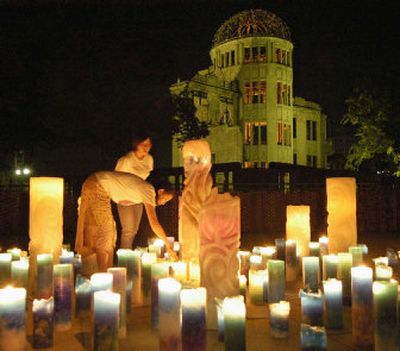Prayers, candles and hope

HIROSHIMA, Japan – For a brief moment, the trolleys stopped and the city fell silent. Then, with offerings of water and flowers for the dead, Hiroshima remembered how a flash in the early morning sky 60 years ago turned life to death for more than 140,000 and forever changed the face of war.
Marking the 60th anniversary of the world’s first atomic bomb attack, more than 55,000 people gathered today in Peace Memorial Park, a sprawling, tree-covered expanse that for one day each year becomes the spiritual epicenter of the global anti-nuclear movement.
The ceremony was austere.
A moment of silence was observed at 8:15 a.m., the instant of the blast, and after a flock of doves was released into the sky. Then wreaths and ladles of water – symbolizing the suffering of those who died in the atomic inferno – were offered at a simple, arch-shaped stone monument at the center of the park.
Outside the nearby A-Bomb Dome, one of the few buildings left standing after the blast, peace activists held a “die in,” where protestors lay on the ground and act dead.
In a “Peace Declaration,” Hiroshima’s outspoken Mayor Tadatoshi Akiba gave an impassioned plea for all nuclear powers to abandon their deadly arsenals, and said the United States, Russia and other members of the nuclear club are “jeopardizing human survival.”
“Many people around the world have succumbed to the feeling that there is nothing we can do,” he said. “Within the United Nations, nuclear club members use their veto power to override the global majority and pursue their selfish objectives.”
In a more subdued speech, Prime Minister Junichiro Koizumi offered his condolences to the dead.
“I offer deep prayers from my heart to those who were killed,” he said, vowing that Japan would be a leader in the international movement against nuclear proliferation.
Though Hiroshima has risen from the rubble to become a thriving city of 3 million, most of whom were born after the war, the anniversary underscores its ongoing tragedy.
Officials estimate that about 140,000 people were killed instantly or died within a few months after the Enola Gay dropped its deadly payload over the city, which then had a population of about 350,000.
Three days later, another U.S. bomber, Bock’s Car, dropped a plutonium bomb on the city of Nagasaki, killing about 80,000 people. Japan surrendered on Aug. 15, 1945, bringing World War II to a close.
The true toll on Hiroshima is hard to gauge, however.
Including those initially listed as missing or who died afterward from a loosely defined set of bomb-related ailments, including cancers, Hiroshima officials now put the total number of the dead in this city alone at 237,062.
This year, about 5,000 names are being added to the list.
“For the people of Hiroshima, this is a day of prayer,” said Takaomi Tahara, who lost several relatives, including his grandfather, in the bombing. To this day, he said, the remains of his dead relatives have not been found. “For us, there isn’t any closure.”
Along with being a time to remember those who died, Hiroshima’s anniversary has become the focus of the international peace movement.
In the biggest pre-anniversary event, about 8,000 people attended the annual World Conference Against Atomic and Hydrogen Bombs. The conference organizers, mainly leftist and labor groups, have collected more than 8.5 million signatures calling for a global nuclear ban.
On the eve of the anniversary, fundamentalist Christians held a prayer circle in Hiroshima, while members of the International Communist League handed out leaflets nearby.